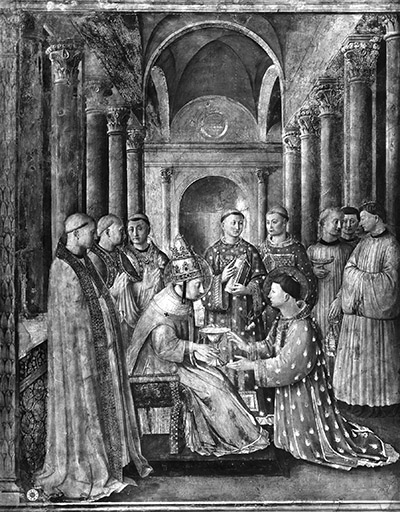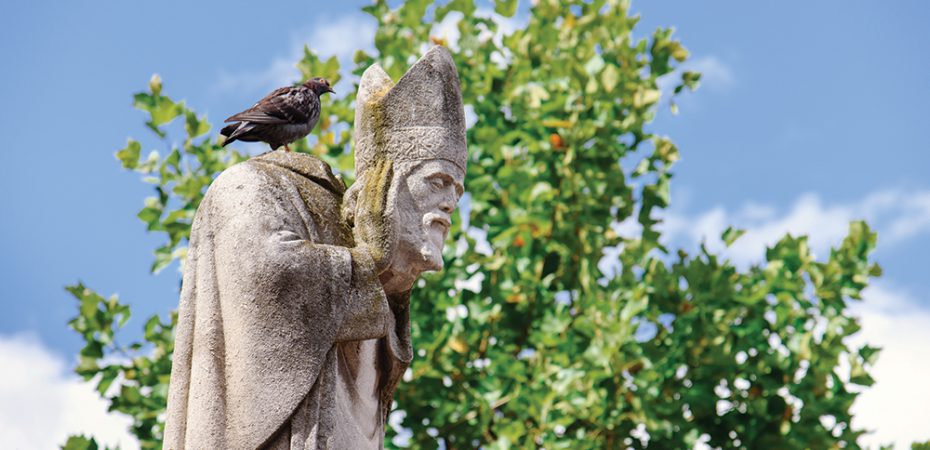The Deacon as Companion
From a supportive role to one who breaks bread with another
Leon Suprenant Comments Off on The Deacon as Companion
Of the many beautiful celebrations throughout the liturgical year, one that has always captured my imagination is the occasional feast day of a saint along with his or her “companions.” For example, one of my sons was baptized on the memorial of St. Denis and Companions (Oct. 9).
Typically on such feast days, the “headliner” is the ranking cleric, often a pope or a bishop, while the “supporting cast” (also known as the companions) are other holy people who, along with their celebrated leader, were martyred for their Christian faith.
While the companions are a diverse group, including religious as well as heroic lay men and women, I have noticed in recent years that some of these so-called companions were deacons. For example, St. Denis was a third-century French bishop, and one of his two companions was the deacon Eleutherius.
Another example is the feast of St. Sixtus II and Companions (Aug. 7). Sixtus was a third-century pope, and his companions were six of his seven deacons — four were martyred with him and two were martyred later that day. It was typical for a local Church to have seven deacons at that time in imitation of the seven reputable men mentioned in Acts 6, who were commonly considered the first deacons.
Sixtus’ seventh deacon, interestingly enough, was St. Lawrence (Aug. 10). At first, Emperor Valerian offered to spare his life in exchange for his handing over of “the treasures of the Church.” St. Lawrence responded by presenting to the emperor the sick, the needy and the marginalized of Rome, which led to his martyrdom four days after the others.
I suspect there would be even more deacon companions were it not for the virtual disappearance of the permanent diaconate in the West for the millennium leading up to the Second Vatican Council (1962-65). Yet, even so, we find individuals who in another era might have been drawn to the diaconate.
The 26 martyrs of Nagasaki in 1597 — now known as St. Paul Miki and Companions (Feb. 6) — were missionaries, religious, catechists and laity. Paul Miki himself was not a priest but was training for the priesthood and likely had already received minor orders. He was a herald of the Gospel who chanted the “Te Deum” on his forced march to the site of his execution and preached to all who would listen even as he hung on the cross.
St. Joseph Mukasa was one of the 19th-century Ugandan martyrs and was a companion of St. Charles Lwanga (June 3). Like Charles, Joseph was a catechist and prepared children for the sacraments. He courageously spoke out and protected young people from the corrupt King Mwanga, who was a pedophile. As Joseph was being executed, he sought the conversion and repentance of Mwanga.
And closer to home, there is St. René Goupil, the first of the North American Martyrs (Oct. 19). Like most deacons, René had a secular occupation. He worked as a physician and surgeon before entering the Jesuit novitiate in 1639. He left the novitiate because of ill health but volunteered to serve as a lay missionary and eventually as a Jesuit lay brother. He died from a tomahawk blow to the head after teaching a Mohawk child the Sign of the Cross, but not before his companion, Father (now St.) Isaac Jogues could give him final absolution.
Sheepdogs and Servants
There are many terms and images used to describe deacons, such as heralds, bridges, intermediaries and envoys. All of these shed light on certain aspects of diaconal ministry.
In the “field hospital” that is the Church, deacons can be thought of as “medics,” ministering to the wounded on the front lines and connecting them with the medicinal balm of the sacraments.
Deacon Harold Burke-Sivers refers to deacons as sheepdogs, as they help run interference for the bishops and priests — the shepherds — but are not the shepherds themselves.
And above all, as their title suggests, deacons are servants, in imitation of their master, who came “not to be served but to serve” (Mk 10:45).
Companion
I suggest that we might add the term companion to this growing list of images.
First, companion suggests a humble, supportive role, which aptly characterizes a significant dimension of the deacon’s ministry. We are reminded of this role in the sacred liturgy, where the presiding bishop or priest has his deacon companion, his right-hand man, always at his side.

Second, as we recall in liturgical celebrations, the companions were martyred right alongside St. Denis, St. Sixtus and others whose names are explicitly remembered at Mass. While not all deacons are called to martyrdom for the Faith, we do well to recall that the first post-Resurrection martyr recorded in Scripture was the proto-deacon, Stephen. It’s the logical progression of following Christ the Servant, who came “to serve and to give his life as a ransom for many” (Mk 10:45).
Third, in common parlance, a companion is one with whom one spends a lot of time or with whom one travels. Isn’t that what the ministry of the deacon often entails? I think this is especially true when we recall that we are but pilgrims in this life, as we continue on our journey to our true and everlasting homeland (cf. Phil 3:12-21). This journey can be long and arduous, fraught with difficulties, challenges and crosses. And the pilgrim Church, in part through the ministry of deacons, accompanies the faithful on this great adventure.
Fourth, and most importantly, we might note that a companion is literally “one who breaks bread with another.” This term clearly has Eucharistic overtones. One calls to mind the encounter on the road to Emmaus, where Jesus becomes a traveling companion of the two disciples — not only on the physical journey to Emmaus but also on their spiritual journey in coming to grips with the death of Jesus of Nazareth.
This journey, or pilgrimage, culminates in their recognizing the risen Lord “in the breaking of the bread” (Lk 24:35), which was an early description of the Eucharist (cf. Acts 2:42, 46; 20:7, 11; Didache 14:1). St. Ephrem of Syria (c. 306-73), the only deacon Doctor of the Church, referred to the daily Eucharist (“qurbono”) as “the breaking of the bread and the cup of salvation” (“On Paradise”).
The deacon is a companion to the bishop and to all the faithful because he is first and foremost a close companion of the Lord Jesus, who is truly present in the Eucharist. It can even be said that in some sense the deacon participates in the companionship of Jesus, who seeks to draw all men and women to himself.
May all of us, in our own journeys of faith, be numbered among the companions of Jesus and his holy ones.
LEON SUPRENANT is co-director of the Office of the Permanent Diaconate for the Archdiocese of Kansas City in Kansas.
…………………………………………………………………………………………………………………………………………………………..
PROCLAIMING THE GOSPEL
“One important challenge is to show that the solution will never be found in fleeing from a personal and committed relationship with God which at the same time commits us to serving others. … We need to help others to realize that the only way is to learn how to encounter others with the right attitude, which is to accept and esteem them as companions along the way, without interior resistance. Better yet, it means learning to find Jesus in the faces of others, in their voices, in their pleas. And learning to suffer in the embrace of the crucified Jesus whenever we are unjustly attacked or met with ingratitude, never tiring of our decision to live in fraternity.”
— Evangelii Gaudium, No. 91
……………………………………………………………………………………………………………………………………………………………





